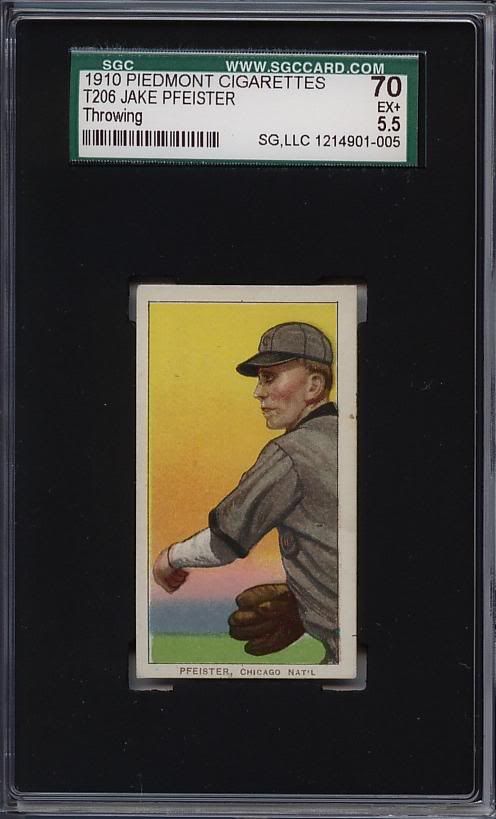Posted By:
T206CollectorI often soak T206 cards to remove glue and paper from the reverse. As I have mentioned many times on this Board, one of my best examples -- Pfeister Throwing -- is now in an SGC 70 holder, even though it once had 3/4 of the back covered in paper:

I don't have a scan of the back, but it is uninteresting. In water, the paper came right off and there was essentially no glue to be found. I love this card, and nobody has to worry about it being circulated any time soon. Contrary to some opinions expressed on this board, grading and soaking mix quite well.
I have never used soaking and pressing to eliminate a crease in a card. I suppose the reason I haven't up to this point is because I have had the same ethical concerns that have been expressed here. I have, however, seen creases minimalized by soaking and then pressing cards from which I just wanted to reduce paper or glue on the reverse. I have not seen the phenomena of the creases reappearing -- and I am very very skeptical that they would.
If you are going to do it, make sure to use water equally applied to the whole card -- not just a drop here and there -- and make sure to press the card very well while drying. The most common problem is that a card doesn't dry properly/evenly and then will warp. The way to get the warping out is to repeat the soaking and drying process until you get a card that is not warped. You should 100% try it on penny cards from the same set until you get a good idea about how to do it. It takes a bit of practice.
For some reason T206 lithographs are not damaged in water. In addition, after the cards dry there is no evidence that they were ever in water. Indeed, given where and how many T206 cards have been stored since 1909, it will never be known which ones have been wet and which ones haven't. In fact, there is at least some chance that your $4,000 beauty was lying at the bottom of a water spill or flood circa 1936, but just dried out nicely after a good pressing beneath the 1937 Gimbels Catalog. That is why the grading companies can't find anything wrong with it. The water comes -- does its trick -- and then leaves without any evidence that it was ever there. (Here, this practice should be distinguished from using chemicals or paint, which adhere themselves to the card fibers and never let go -- though, as has been stated on this Board many times, art restoration is commonplace in the multi-million dollar world of art collecting.)
For those that raise eyebrows about such tactics, I want to share an old Steven Wright joke with you:
"While I was gone, someone stole everything in my apartment and replaced it with an exact replica."
If this happened to many of you, I suppose you would call the police and complain that they had been robbed. The rest of us wouldn't really care, but for the fear that the thieves might return and take something without replacing it with a replica.
When I get really rich one day, I am going to buy one of those machines that NASA uses on Mars that can detect the former presence of water in things. I will then, free of charge, offer this service to any Net54er with vintage baseball cards. If I can confirm the former presence of water in your card, I will be happy to purchase that card -- but for a nice discount, of course.